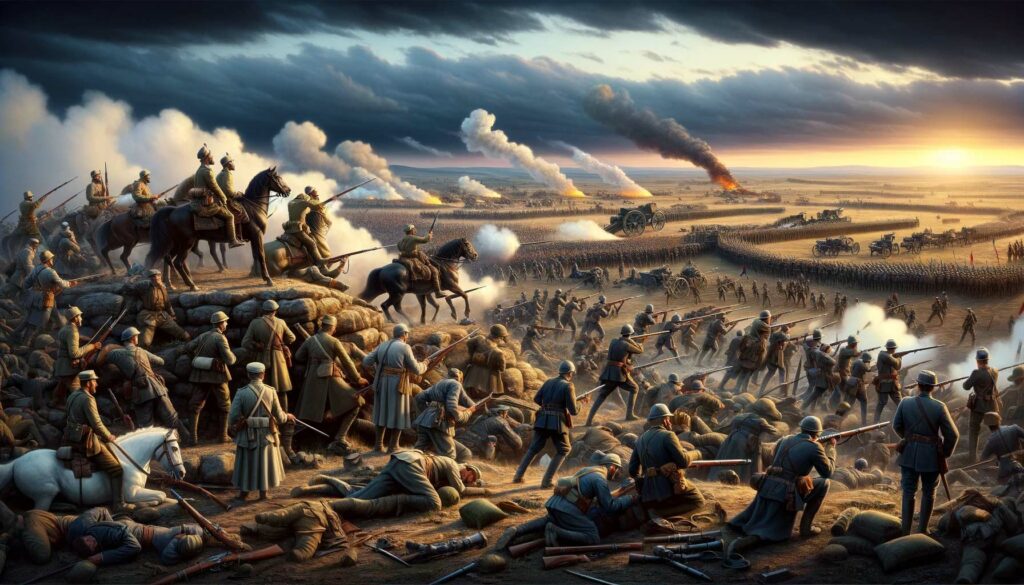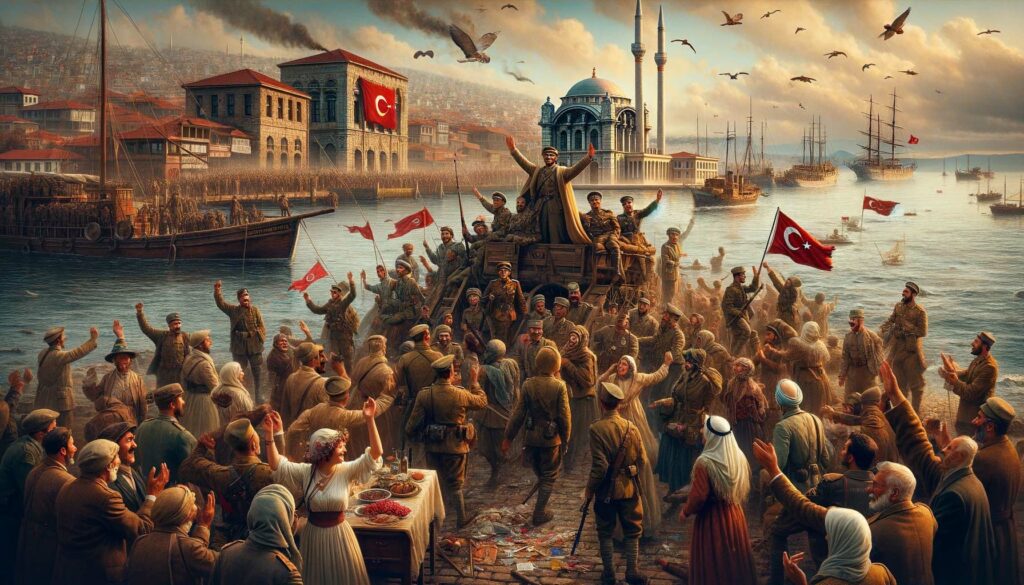Explore the Turkish War of Independence (1919-1923): its causes, key figures, major battles, turning points, and global impact in this detailed historical analysis.
The Turkish War of Independence, spanning from 1919 to 1923, marks a pivotal chapter in the annals of modern history. This conflict not only led to the establishment of the Republic of Turkey but also significantly altered the geopolitical landscape of the post-World War I era. It emerged from the ashes of the Ottoman Empire’s defeat in World War I, facing partitioning by the victorious Allied Powers under the Treaty of Sèvres. The war represents a monumental struggle for sovereignty, national identity, and a new political order under the leadership of Mustafa Kemal Atatürk. This article delves into the intricate details of the war, exploring its causes, key participants, decisive moments, and lasting consequences.

What Were the Reasons for the Turkish War of Independence (1919-1923)?
The roots of the Turkish War of Independence lie in the complex aftermath of World War I. The Ottoman Empire’s defeat and the harsh terms of the Treaty of Sèvres in 1920, which proposed the partitioning of its territories among the Allied Powers, ignited a nationalistic fervor among Turks. The treaty threatened the dissolution of Turkish sovereignty by allocating vast regions to Greece, Armenia, and the newly formed Kurdish state, while placing strategic straits under international control. The Ottoman government’s capitulation to these terms provoked widespread dissent, leading to the rise of a nationalist movement determined to resist foreign domination and dismemberment. This movement found its voice in Mustafa Kemal (later Atatürk), who rallied military and civilian support for a struggle against both the occupying Allied forces and the Ottoman Sultanate, seen as complicit in the empire’s disintegration. The sense of betrayal and the imminent threat of national extinction catalyzed the Turkish populace’s determination to fight for independence, sovereignty, and a unified nation-state.
Who Was Involved in the Turkish War of Independence (1919-1923)?
The Turkish War of Independence saw a diverse array of actors on both the national and international stages. The primary protagonist was the nationalist movement led by Mustafa Kemal Atatürk, which comprised former Ottoman military officers, civilians, and various ethnic groups within the remnants of the Ottoman Empire who opposed the Treaty of Sèvres. This movement coalesced into the Grand National Assembly (GNA) in Ankara, symbolizing the legislative and executive power of the nascent Turkish state. Opposing them were the Allied Powers, particularly Greece, which was actively involved in military operations on Anatolian soil, and Armenia, with territorial disputes in the east. The British Empire, France, and Italy played significant roles in the political and military support of these operations, although their involvement fluctuated due to changing European interests and the emerging nationalist movements within their own colonies. Additionally, the Ottoman Sultanate and its loyalists, who favored a compromise with the Allies to preserve the empire’s remnants, stood as internal adversaries to the nationalist cause. The war’s dynamics were further complicated by the presence of various ethnic and religious groups within the empire, whose allegiances were divided between the prospect of independence under the nationalists or protection under the auspices of foreign powers.
The Leaders of the Turkish War of Independence (1919-1923)
Mustafa Kemal Atatürk emerges as the indomitable leader of the Turkish War of Independence. A visionary military officer and statesman, Kemal’s leadership transformed the course of Turkish history. His adeptness in military strategy and political maneuvering enabled him to unify diverse nationalist forces against a common enemy. Kemal’s foresight led to the establishment of the Grand National Assembly in Ankara, effectively setting the foundation for a new, secular republic. His counterparts, such as İsmet İnönü and Fevzi Çakmak, played crucial roles in military operations and diplomatic negotiations. On the opposing side, leaders like King Constantine I of Greece and Eleftherios Venizelos were significant figures, driving Greek military ambitions in Asia Minor. Internationally, figures like British Prime Minister David Lloyd George influenced the Allied stance towards Turkey. These leaders’ actions, strategies, and decisions critically shaped the war’s progression and its outcome. Post-war, Atatürk and his comrades would redefine Turkey’s political, cultural, and legal landscapes, establishing the Republic of Turkey and radically altering its societal structures.
Was There a Decisive Moment?
The landing of Greek forces in Smyrna (Izmir) on May 15, 1919, serves as a decisive moment that catalyzed the onset of the Turkish War of Independence. This event symbolized the tangible manifestation of the Treaty of Sèvres’ implications, directly challenging Turkish sovereignty and igniting widespread nationalistic outrage. It provided Mustafa Kemal and the nationalist movement with the impetus to organize a coordinated resistance, marking the beginning of a concerted effort to reclaim Turkish territory and sovereignty from foreign control. The occupation of Smyrna was not only a military challenge but also a profound affront to Turkish national pride, serving as a rallying cry for those who would join the struggle for independence.
What Were the Major Battles?
The Turkish War of Independence was marked by several key battles and campaigns that shaped the conflict’s outcome. These include:
- The Battle of İnönü (January-March 1921): The first and second battles of İnönü were pivotal early victories for the Turkish nationalists. Led by İsmet İnönü, these victories proved the effectiveness of the nationalist forces and boosted morale, showing that the Greek advance could be halted.
- The Battle of Sakarya (August-September 1921): Spanning over three weeks, this battle marked a turning point in the conflict. Mustafa Kemal personally oversaw the defense, which halted the Greek advance towards Ankara. The battle’s outcome shifted the momentum in favor of the Turkish forces and set the stage for a counter-offensive.
- The Great Offensive (August 26, 1922): This counter-offensive, also known as the Battle of Dumlupınar, culminated in a decisive victory for the Turkish forces. Under the command of Mustafa Kemal, the offensive effectively crushed the Greek forces in Anatolia, leading to the liberation of İzmir and eventually the end of Greek presence in Asia Minor.
- The Liberation of İzmir (September 9, 1922): The recapture of İzmir symbolized the culmination of the Turkish struggle for independence. The city’s liberation marked the effective end of the war and paved the way for the negotiation of a new treaty to replace the Treaty of Sèvres.
These battles, among others, were characterized by strategic brilliance, tenacity, and the indomitable will of the Turkish forces. Leaders like Mustafa Kemal Atatürk, İsmet İnönü, and Fevzi Çakmak played crucial roles in these victories, which collectively turned the tide of the war in favor of Turkish independence.
Was There a Turning Point?
The Battle of Sakarya represents a critical turning point in the Turkish War of Independence. This prolonged engagement demonstrated the resilience and determination of the Turkish nationalist forces under dire circumstances. The successful defense of Ankara’s approaches and the subsequent shift in strategic initiative forced the Allies to reconsider their positions and opened the door for Turkish diplomatic and military counter-offensives. The psychological impact of this victory on both Turkish and Greek forces, along with the international community, significantly altered the course of the conflict, leading to a reevaluation of the feasibility of the Treaty of Sèvres and setting the stage for the eventual negotiation of the Treaty of Lausanne.

The Consequences of the Turkish War of Independence (1919-1923)
The Turkish War of Independence resulted in profound and lasting changes. The establishment of the Republic of Turkey under the leadership of Mustafa Kemal Atatürk heralded the end of the Ottoman Empire and the birth of a secular, nationalist state. The Treaty of Lausanne (1923) rectified the Treaty of Sèvres, recognizing Turkish sovereignty over Anatolia and Eastern Thrace. This war fundamentally altered the region’s ethnic and cultural landscape through population exchanges and reforms that aimed to create a homogeneous nation-state. Internationally, the conflict influenced colonial subjects worldwide, inspiring movements for national liberation and self-determination. For the parties involved, especially Greece and the Armenian and Kurdish communities, the war had significant and often tragic consequences, reshaping populations and national borders. The Republic of Turkey’s emergence as a secular, nationalist state also set a precedent for governance and reform in the region, influencing subsequent political and social developments.
The Turkish War of Independence was a watershed in the transition from empire to nation-state in the early 20th century, fundamentally reshaping Turkey’s identity and its role on the world stage. Under the leadership of Mustafa Kemal Atatürk, Turkey underwent a radical transformation, casting off the vestiges of the Ottoman Empire to emerge as a secular, modern nation-state. The war not only redefined national borders and identities but also had a lasting impact on international relations, serving as a testament to the power of national will and the desire for self-determination. The legacy of this conflict and its leaders continues to influence Turkey and the broader region, underscoring the enduring significance of the struggle for independence and sovereignty in shaping the modern world.
Back to the Wars section